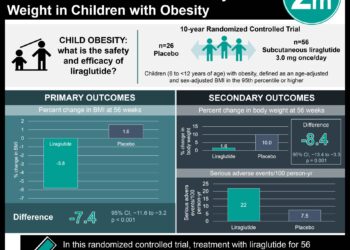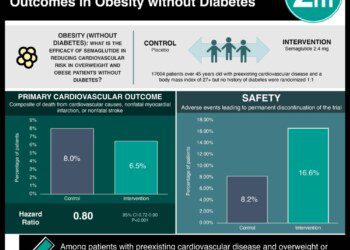Fluctuating Weight-for-Length Trends in Infants from 2000 to 2014
1. The prevalence of infants with high weight-for-length ratios increased from 13.4% in 2000 to 14.5% in 2004, remained constant from 2004 to 2010, and decreased to 12.3% in 2014
2. Significant differences were found across race-ethnicity groups, with higher incidences of high weight-for-length ratios in American Indian and Hispanic infants than in black, white, and Asian/Pacific Islander infants.
Evidence Rating Level: 2 (Good)
Study Rundown: There are many studies documenting trends in obesity in the pediatric population. However, what is lacking is information on relative weight among infants, referred to as the weight-for-length ratio. This study aimed to examine these trends and quantify infants that were considered “high” in weight-for-length. Results showed that the overall prevalence of infants with high weight-for-length increased from 13.4% in 2000 to 14.5% in 2004. From 2004 to 2010, the prevalence remained constant at 14.5%. In 2014, this prevalence decreased to 12.3%. Results were further analyzed by age, sex, race-ethnicity, and relative income. Significant differences were found across race-ethnicity groups, with higher incidences of high weight-for-length ratios in American Indian and Hispanic infants than in black, white, and Asian/Pacific Islander infants. In addition, relative income was found to be inversely proportional to the prevalence of high weight-for-length ratios. Limitations of this study include a definition of high weight-for-length ratio that differs from the CDC and the fact that these findings may not be generalizable, as they only apply to infants in enrolled in the WIC program. Nonetheless, pediatricians and primary care providers should be aware of these findings as children that are considered to have a high weight-for-length ratio are at increased risk for obesity. In addition, these statistics can aid in the development of obesity prevention policies aimed at high-risk children.
Click to read the study, published today in Pediatrics
Relevant Reading: Early Childhood Obesity Prevention Policies
In-Depth [survey]: Weight-for-length data was gathered for infants ages 3 to 23 months from the Women, Infants and Children Program Characteristics (WIC-PC) survey from 2000 to 2014 (n=16,927,120). Weight-for-length was considered high if it was 2 standard deviations above the sex and age-specific-mean set forth by the World Health Organization. The prevalence of infants with high weight-for-length ratios increased from 13.4% in 2000 to 14.5% in 2004, remained constant from 2004 to 2010, and decreased to 12.3% in 2014. Substantial differences existed among infants of difference race/ethnicities: in 2014, American Indian and Hispanic Children had a higher prevalence of high weight-for-length infants (15.6% and 13.8% respectively) when compared to white (11.0%), black (11.9%) and Asian/Pacific Islander infants (8.5%). In addition, the prevalence of high weight-for-length was inversely associated with the relative income of the family. Further analysis of location indicated that the prevalence of high weight-for-length infants decreased in 40 states and 3 of 5 US territories from 2000 to 2014. The largest changes were seen in Kentucky (decreased by 7%), Puerto Rico (decreased by 9%), and West Virginia (increased by 2%).
Image: PD
©2015 2 Minute Medicine, Inc. All rights reserved. No works may be reproduced without expressed written consent from 2 Minute Medicine, Inc. Inquire about licensing here. No article should be construed as medical advice and is not intended as such by the authors or by 2 Minute Medicine, Inc.







![Novel biodegradable sirolimus-eluting stents non-inferior to durable everolimus-eluting stents [BIOSCIENCE trial]](https://www.2minutemedicine.com/wp-content/uploads/2014/09/Taxus_stent_FDA-e1607803635904-75x75.jpg)